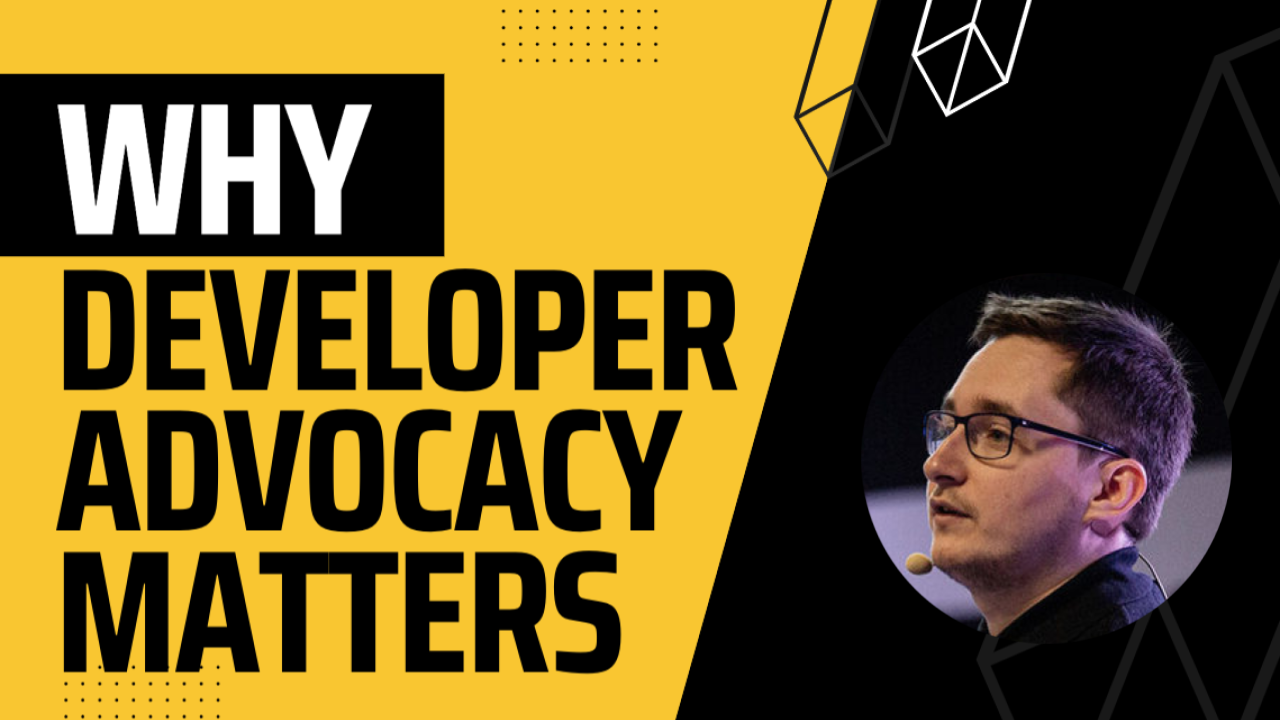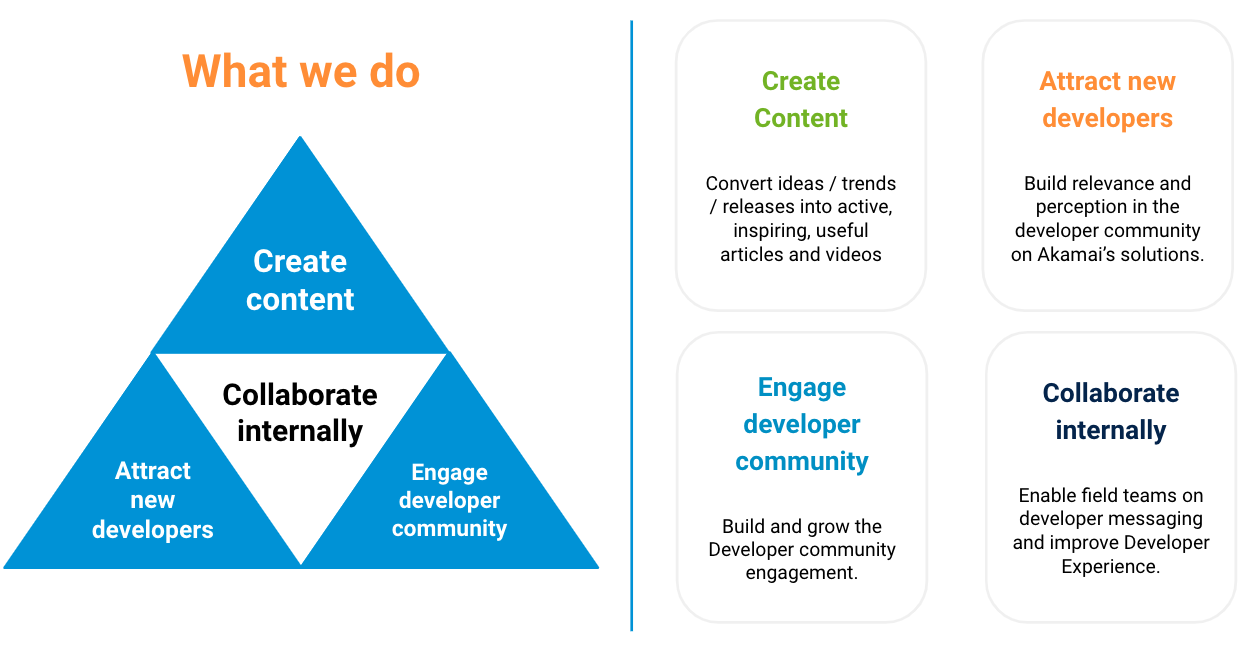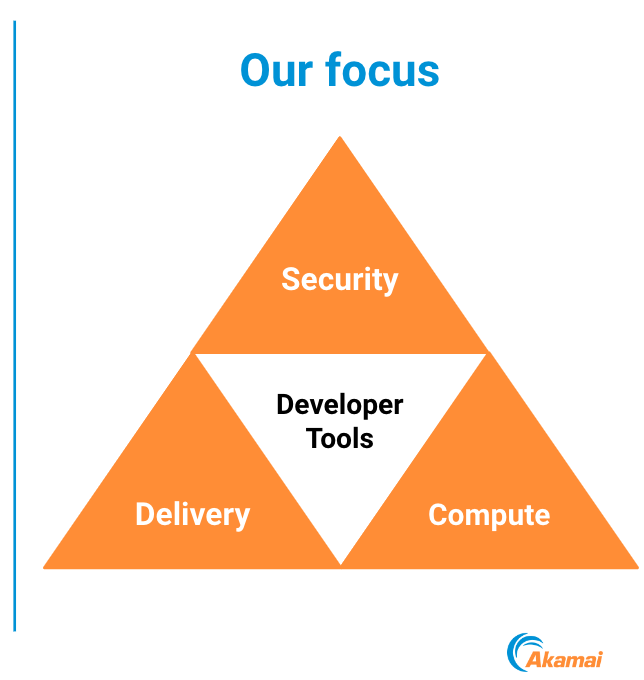Why Developer Advocacy matters...
 Mike Elissen
Mike Elissen
My three-year journey as a Developer Advocate @ Akamai has been an amazing ride. I have been working at Akamai Technologies for the last decade in a variety of developer-facing roles, all focused on helping developers utilize Akamai's solutions such as delivery, security and computing in the best way possible.
My journey started in Professional Services, end-responsible for integrating Akamai solutions which later led me to a three-year stint in Presales, responsible for consulting developers on the value of application security and content delivery. I felt all of those years were training, training that led me to become a Developer Advocate.
The question we need to answer first is, what is a Developer Advocate?
A Developer Advocate is a technical evangelist who helps to promote a company's solutions and technologies to developers. A perfect Developer Advocate would have several key qualities and abilities.
First, a Developer Advocate would have a deep understanding of the company's products and technologies. This would allow them to effectively communicate the technical details and benefits of the products to developers, and to answer any technical questions that developers might have. Luckily, I have been fortunate to achieve this through my experience in Professional Services and Presales.
Second, a Developer Advocate would have excellent communication skills. They would be able to clearly and concisely explain complex technical concepts to a wide range of audiences and would be able to tailor their messaging to the specific needs and interests of different groups of developers. Creating workshops and running training courses as well as creating video tutorials on YouTube have given me the experience needed to excel as a Developer Advocate.
Third, a Developer Advocate would have a strong network of connections in the developer community. They would be well-known and well-respected by other developers and would have a track record of successful engagements with developers through events, online forums, and other channels. Working at Akamai has allowed me to learn from a wide variety of organizations operating in different verticals worldwide. Their technology challenges requiring Akamai solutions have allowed me to grow a good network of developers I can reach out to, to validate new solutions and ideas.
Fourth, a perfect Developer Advocate would be passionate about technology and about helping other developers. They would be excited about the company's solutions and technologies and would be eager to share their knowledge and expertise with other developers. The true 'bread and butter' of why I love working at Akamai is this. The ability to take technology and best position it so internet challenges are addressed properly is why I enjoy going to work (almost) every day.
Overall, a Developer Advocate is a technical expert with strong communication skills, a strong network of connections, and a passion for helping other developers.
Getting a role in Developer Advocacy can be a challenge, both for the (budding) Developer Advocate and the company looking to expand their Developer Advocacy programs.
Critically, Developer advocacy is a field that focuses on building and maintaining relationships with developers. Yea, the goal of developer advocacy is to promote a company's technology and products and to get developers to use and build on top of them.
There are several ways in which developer advocacy can contribute to the revenue growth of a company and why companies are heavily investing in this area:
Increase adoption: By promoting a company's technology and products to developers, developer advocates can increase their adoption, which can lead to increased usage and revenue.
Improve product development: By engaging with developers, developer advocates can gather valuable feedback and insights that can be used to improve a company's products, making them more attractive to developers and customers.
Create new revenue streams: By working with developers to build new applications and integrations on top of a company's technology, developer advocates can create new revenue streams for the company.
Increase brand awareness: Developer advocates can help increase a company's brand awareness among developers, which can lead to increased interest in the company's products and services, and ultimately, increased revenue.
In my three-year journey as a Developer Advocate, this has been the mission I have lived by. In my Presales stint, Developer Advocacy at Akamai was still in the early infancy stages. Automation, Developer Tools and non-UI driven use-cases were brand new to the company and knowledge of these tools was limited, let alone the knowledge of these tools with the developers using the Akamai solutions.
As new technology excites me - thinking back, I remember launching my first API interactions in 2017, making simple Akamai purge requests to refresh the content of the Akamai Content Delivery Network (CDN) to fully-fledged Akamai provisioning with Infrastructure as Code in 2022 - I find it a personal challenge to myself to learn new technology and be able to educate developers on the best use of it, whether this is content delivery, web application and API protection, cloud computing, Infrastructure as Code or any of the other amazing technologies Akamai operates in.
In my role as a Developer Advocate at Akamai, I can do just that while also contributing to the companies' overall goals and ensuring that our developers and the companies they represent are happy!

Alright, now that we have established what a Developer Advocate is and why companies are investing in Developer Advocacy, it is time to take a look at the strategies Developer Advocacy teams can employ. Of course, these vary from company to company, and the pandemic has seen all of us adapt to the execution of ideas, but these have been successful at Akamai for the last three years.
Developing and maintaining relationships with developers is a key aspect of developer advocacy. This can involve a variety of activities, such as:
Providing technical support and guidance to developers who are using your product or service. My colleagues with limited experience in automation or Akamai Developer Tools often ask me to join customer meetings or host workshops to help them better utilize Akamai.
Creating and sharing technical content, such as blog posts, video tutorials, and documentation, to help developers learn about your product and how to use it. It has been a blast creating tons of video tutorials in the last three years and more recently, launching a dedicated blog here with helpful content for those who are looking to learn about Akamai.
Participating in developer communities and forums to answer questions and engage with developers. This has been a challenge in real life for the last three years but online communities such as StackOverflow, LinkedIn, Twitter, Slack and dedicated Akamai community pages have allowed me to help developers directly. Answering a question for developer A has often allowed me to easier answer developer B who has a similar question, sometimes even on the same day.
Hosting or attending events, such as meetups, conferences, and hackathons, to connect with developers in person. Yes, this has been the biggest challenge for all of us but participating in and running online webinars or conferences has been great. In-person events are slowly returning in the last 9 months and I am looking forward to seeing our developers in person more often in 2023.
Working closely with the product and engineering teams to understand the needs of developers and to ensure that your product meets those needs. To me, this has been the most challenging and most rewarding part of the strategy, not only to benefit myself and learn new skills but for the benefit of our developers. In the past, it was easy to complain about a lack of features, but working directly with engineers, product managers, and technical writers on directly improving solutions, Developer Tools and documentation has been game-changing for me. This is often the most overlooked area within Developer Advocacy as it does not lead itself to be easily tracked - presenting at events of video views is much easier to track - but seeing Akamai go from having no Terraform Provider in 2019 to a fully-fledged full-portfolio covering and verified Terraform Provider that I was able to contribute to has been very rewarding.
It's important to remember that every team is different, and the specific strategy that works best for you will depend on your goals and the needs of your target audience. It's a good idea to start by identifying your target audience and understanding their needs, and then tailor your strategy accordingly. It also heavily depends on where your company is in terms of an overall strategy - a start-up could benefit from different areas versus a mature organization that is opening up its platform to developers.
In the three years in the Developer Advocacy team at Akamai, there have been a ton of changes in team structure for a variety of reasons. That said, I feel that now at the end of 2022, we have achieved the perfect setup for a successful and well-executing Developer Advocacy team.
A perfect developer advocacy team, or also known as a developer relations team, is a group within an organization that is responsible for building and maintaining relationships with software developers and the broader developer community.
The structure of a developer advocacy team can vary depending on the needs and goals of the organization, but here are some common elements that you might find in a developer advocacy team:
A team leader and/or program manager: This person is responsible for managing the team, setting goals and objectives, and ensuring that the team is aligned with the overall strategy of the organization and executes this well.
Community managers: These individuals are responsible for engaging with developers and building relationships within the community. This can involve things like organizing meetups, answering questions on forums and social media, and contributing to open-source projects.
Content creators: These team members are responsible for creating and distributing educational and promotional content about the organization's products or services. This might include blog posts, tutorials, and presentations.
Technical evangelists: These team members are technical experts who can speak to developers about the organization's products or services in a way that is both technical and engaging. They may also work with the product team to provide feedback and ideas based on their interactions with developers. At Akamai, we have combined the content creator and technical evangelist roles into one 'Developer Advocate' role covering a specific set of technologies and challenges that Akamai operates in.
Event coordinators: These team members are responsible for organizing and promoting events, such as conferences, meetups, and hackathons, that are aimed at engaging with developers.
Content producer: These team members are responsible for optimizing the content and making sure it best fits the content type or platform. We have content editors in place both for written and video content to help make the content attractive and edited to perfection.
Depending on the size and needs of the organization, the developer advocacy team may also include other roles, such as social media managers, marketing specialists, and data analysts. The key is to have a diverse team with a range of skills and expertise that can help the organization effectively engage with and support developers. Start-ups might see a Developer Advocates fulfill multiple roles at once and at the start of my tenure, I had to wear many hats but it has been amazing to see our team grow in size and maturity over the years.
The Developer Advocacy team itself cannot possibly succeed at all these tasks alone. Working at large organizations such as Akamai, there are thousands of internal developers and technical resources that can help contribute to the Developer Advocacy strategies.
One such project was the launch of an internal subject matter expertise program that I run called the Akamai Developer Champions program.

The Developer Champions program looks to combine the strengths and expertise of teams within Akamai such as Professional Services, Presales, Product Marketing and more and collaborate across teams and regions to help improve the overall Developer Experience overall for our developers.
There are several benefits to running an internal subject matter expert (SME) program:
Improved efficiency: By identifying and cultivating SMEs within your organization, you can more quickly access the specialized knowledge and expertise needed to solve problems and make informed decisions. This can help improve efficiency and productivity.
Enhanced credibility: Having a recognized group of SMEs within your organization can enhance your credibility and reputation as a knowledgeable and competent company.
Increased employee engagement: Participating in an SME program can be a rewarding and challenging opportunity for employees, which can increase their engagement and motivation.
Improved communication and collaboration: SMEs can act as a bridge between different departments or teams, facilitating communication and collaboration and helping to break down silos.
Greater innovation: By tapping into the collective expertise of your SMEs, you may be able to generate new ideas and approaches, leading to greater innovation within your organization.
Overall, a well-run internal SME program can help your organization stay up-to-date on the latest developments and best practices in your industry, and can provide a valuable resource for employees seeking guidance and support.
The Akamai Developer Champions have a dedicated collaboration chat group to ask for help and recurring monthly meetings are held for brainstorming and sharing updates across the company. The Developer Champions program has been very successful with additional content (blogs, technical tutorials, videos) created to help the Developer Advocates scale as well as assist the Developer Experience Engineering teams help test new Developer Tools, new releases/bugfixes and even create brand-new tools that benefit our developers.
Akamai runs an internal innovation and ideation program called Akamai Wizards and I am proud to see that ideas contributed by Developer Champions have made the top 3 in the last three years, even winning the competition in 2022.
Everyone at Akamai is busy directly helping our developers achieve the best that they can. Still, I aim to motivate others to help create content that can be launched to a wider audience.
Motivating others to create technical content can be a challenging task, especially if the person is not naturally inclined to write or share their knowledge. In my experience, here are a few strategies that you might find helpful:
Communicate the benefits: Help the person understand the benefits of creating technical content, such as increased visibility within their field, the opportunity to share their expertise with others, and the chance to hone their writing skills.
Offer support and encouragement: Encourage the person to take on the task and offer support along the way. This could include providing resources or offering to help with editing and proofreading.
Set specific goals: Help the person set specific, achievable goals for creating technical content, and provide guidance and feedback as they work towards those goals.
Create a supportive community: Encourage the person to share their work with a supportive community of peers, such as a writing group or an online forum. This can provide a sense of accountability and help them feel motivated to continue creating content.
Reward and recognize effort: Consider offering rewards or recognition for those who take on the task of creating technical content. This could be something as simple as public recognition or a small gift.
I have worked first-hand with the smartest technical resources here at Akamai and every day they motivate me to learn more myself. Seeing Developer Champions write down their ideas, the ways they combine technologies or even jump straight into new technologies we launch either through in-house development or acquisitions is inspiring and I am very grateful to see this happen at a wide scale at the company. Fostering a sharing-is-caring culture within your company brings many benefits for both the individual sharing, the individual learning and the organization as a whole.
So far, the journey here at Akamai as a Developer Advocate has been extremely rewarding, for the growth of my skills and doing something fun that keeps me excited, but also for the company. Of course, not everything is perfect and there is always room to improve. I will dive into general areas of improvement and challenges to solve that I have seen, not only at Akamai but also at other companies that are running Developer Advocacy programs/teams who have been gracious in sharing their insights.
There are several reasons why technology companies may struggle to engage and attract developers:
Competition: Many technology vendors are competing for developers' attention and time. This can make it difficult for a particular vendor to stand out and attract developers. Especially with the thousands of DevOps tooling available out there - it is a challenge for sure.
Limited resources: Some technology vendors may have limited resources, which can make it difficult for them to effectively engage and attract developers. This could be due to budget constraints or a lack of personnel dedicated to developer outreach.
Poor documentation: If a technology vendor's documentation is poorly written or difficult to understand, it can be a major barrier to attracting developers. Poor documentation can make it difficult for developers to learn how to use the technology effectively, which may discourage them from using it. Luckily, Akamai has launched the brand-new Akamai TechDocs platform, running on ReadME.io. I was glad to be part of creating, reviewing and curating content for this with the amazing Tech Writing team we have at Akamai.
Lack of community support: Developers often rely on online communities for support, guidance, and inspiration. If a technology vendor lacks a strong online community, it may be more difficult for them to attract developers. This is an area of improvement for Akamai and we may have something in the works to address in the short term.
Poor marketing: If a technology vendor does not effectively market their technology to developers, it can be difficult for them to attract attention and adoption. This may be due to a lack of understanding of the developer audience, or a lack of resources dedicated to marketing efforts. Developers are different from your management / Cxx-level audience and require a different approach.
For those in Developer Advocacy teams or operating one, I would be remiss in sharing some common pitfalls you could run into:
There are several common pitfalls that developer advocacy teams can encounter:
Lack of focus: It can be tempting to try to be everything to everyone, but this can dilute your efforts and make it difficult to achieve any real impact. It's important to have a clear focus and to prioritize your efforts accordingly.
Not listening to the community: Developer advocacy is all about engaging with developers and understanding their needs and concerns. If you're not actively listening to the community and taking their feedback into account, you risk alienating your audience and failing to deliver value.
Not having a clear call to action: Developer advocacy efforts should always have a clear goal in mind, whether it's encouraging developers to use a particular product or technology, or promoting a new feature or release. Without a clear call to action, it can be difficult to measure the success of your efforts.
Failing to measure impact: It's important to track the impact of your developer advocacy efforts and to use this data to inform your strategy. Without this, it can be difficult to understand what's working and what's not and to make informed decisions about where to focus your efforts.
Ignoring the competition: It's important to keep an eye on what your competitors are doing and to understand how your efforts compare. If you're not actively monitoring and analyzing your competition, you risk falling behind.
Failing to adapt: The world of technology is constantly changing, and developer advocacy efforts need to be flexible and adaptable to stay relevant. If you're not willing to change and evolve your strategy, you risk falling behind.
All of these need to be carefully assessed and this is why having a 'Strategist' in your Developer Advocacy team can be a lifesaver. Spending a decent amount of time brainstorming with your team to come up with new ideas and projects will be time saved in the long run.
Overall, being a developer advocate or part of a Developer Advocacy team can be a rewarding and challenging role that involves promoting and supporting the adoption of a particular technology or platform.
To summarize, to become a better developer advocate, it can be helpful to focus on the following areas:
Technical knowledge: A strong foundation in the technology you are advocating is essential. You should be familiar with the various features and capabilities of the technology, as well as its strengths and limitations. This will allow you to answer technical questions and provide guidance to developers.
Communication skills: As a developer advocate, you will be interacting with developers, users, and other stakeholders regularly. You should have strong communication skills, including the ability to explain complex technical concepts clearly and concisely. You should also be able to communicate effectively through a variety of mediums, including written, verbal, and visual.
Community building: Building and engaging with a community of developers is an important part of being a developer advocate. This can involve organizing meetups, hackathons, and other events, as well as participating in online communities and forums. You should be able to foster relationships with key community members and encourage collaboration and adoption of the technology.
Marketing and outreach: As a developer advocate, you will be responsible for promoting the technology and building awareness among developers. You should have a strong understanding of marketing principles and be able to develop and execute effective marketing campaigns. You should also be able to identify and reach out to key influencers and decision-makers in the developer community.
Adaptability and continuous learning: The tech industry is constantly evolving, and as a developer advocate, you will need to stay up-to-date on the latest trends and developments in the field. You should be willing to learn and adapt to new technologies as needed and be able to stay up-to-date on the latest best practices in the field.
All of the areas above are why I continue to enjoy my days as a Developer Advocate. There is a major overlap with previous roles I had at Akamai, in both Professional Services and Presales but it is a good overlap. In the end, what matters most to me, is seeing happy developers (customers) that are making the most of the Akamai solutions that they are using.

I am looking forward to 2023, where through the strategic acquisition of Linode in 2022, Akamai can offer even more solutions to technology challenges in both the delivery, security and computing space.
Thanks to all my readers this year! I hope the content I have created has been beneficial to you and help you learn more. I will be back to share my thoughts on the state of DevOps / DevSecOps for 2023 and continue to share my thoughts on API Security and infrastructure as Code!
To all the developers I have interacted with this year as well as my colleagues here at Akamai - thank you for another successful year and for making my job a fun hobby that makes me come back for more! Looking forward to seeing what you will build with Akamai in 2023!
And special thanks to everyone who has been helping me in my journey as a Developer Advocate - the mentors, the managers, you know who you are and for those no longer at Akamai, you are missed!
(Note for Hashnode audience: This is sort of Dev Retro 2022 compatible.)
Subscribe to my newsletter
Read articles from Mike Elissen directly inside your inbox. Subscribe to the newsletter, and don't miss out.
Written by

Mike Elissen
Mike Elissen
In today's world, it is difficult to stay secure with your applications, APIs and data. I can help you. Mike Elissen, Developer Advocate @ Akamai Technologies.